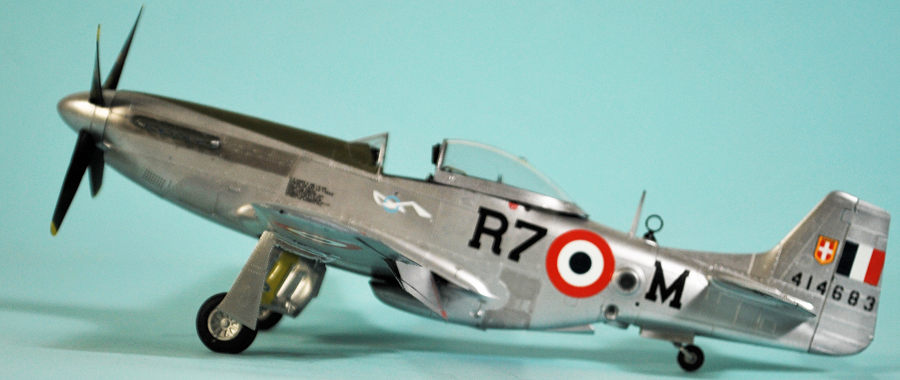
Eduard 1/48 F-6D/K Mustang
| KIT #: | 82103 |
| PRICE: | $55.00 |
| DECALS: | Six Options |
| REVIEWER: | Tom Cleaver |
| NOTES: | Carpena “P-51D/F-6D Armee de l’Air” decals |

| HISTORY |
The Allison-powered Mustang I had excellent low-level performance, which resulted in the aircraft being utilized in the low-level tactical reconnaissance role. The success was such that the USAAF adapted the P-51A for the role, designating it the F-6A. Dallas-built P-51Cs and P-51Ks were modified on the production line as F-6C or F-6K, while Los Angeles-built P-51Ds were modified as F-6Ds. A total of 110 F-6Cs and 175 F-6Ds were accepted by the USAAF. The recon Mustangs served in western Europe, the China-Burma-India theater and in the Philippines and on Okinawa. The F-6D became the RF-51D after the Air Force became an independent service and provided important service during the Korean War.
French Use of the F-6 Mustang:
In the aftermath of the Allied landings in Algeria and Morocco, the former Vichy-controlled French forces became part of the Allied forces. Armée de l'Air Groupe de Reconnaissance II/33 Savoie was equipped with obsolete Bloch 174 aircraft. As other French Air Force units re-equipped with U.S. equipment, rumor spread that the group would re-equip with F-5 Lightnings and F-6 Mustangs. The F-5s arrived in March 1943, re-equipping the first squadron. The Bloch 174s of the second squadron were withdrawn in September 1943. By December, it had been decided the squadron would become a tactical recon unit. They were first trained on Hurricanes, then provided Spitfire V’s modified with a camera in the radio compartment.
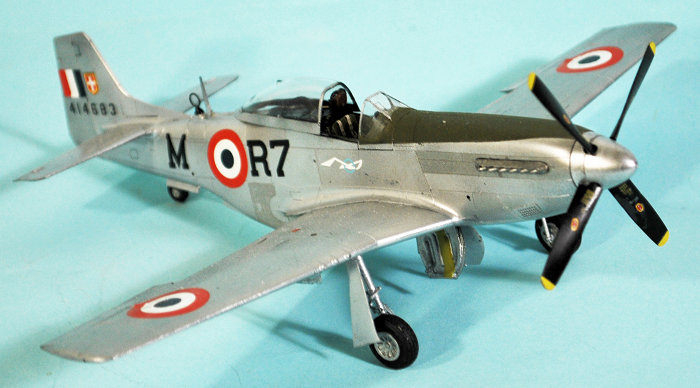 After
participating in the Italian campaign, the unit transferred tp Corsica in June
1944 from where it participated in the invasion of Southern France. On August
22, the squadron re-equipped with Spitfire IX fighter-recon aircraft.landed at
Ramatuelle in France, marking the long-awaited return to the native soil of the
aircrews. The unit later moved to Saint Laurent-de-Mure, Dijon-Longvic and
Luxuil-les-Bains, doing an important job of reconnaissance for the Allied armies
advancing northward.
After
participating in the Italian campaign, the unit transferred tp Corsica in June
1944 from where it participated in the invasion of Southern France. On August
22, the squadron re-equipped with Spitfire IX fighter-recon aircraft.landed at
Ramatuelle in France, marking the long-awaited return to the native soil of the
aircrews. The unit later moved to Saint Laurent-de-Mure, Dijon-Longvic and
Luxuil-les-Bains, doing an important job of reconnaissance for the Allied armies
advancing northward.
On November 14, 1944, Cdr. Marcel Martre took command. In the face of the coldest winter in Europe in over a century, seven Spitfires were lost to weather-related accidents.
On January 1, 1945, the two squadrons were reorganized. The first squadron GR I/33 Belfort kept its F-5 Lightnings. The second, GR II/33 Savoie, remained a tactical photographic and visual reconnaissance unit. The USAAF agreed to supply 20 F-6C and F-6D photo-reconnaissance Mustangs. The F-6Cs were hand-me-downs from the USAAF 111th TRS. The first, F-6C-10NT 43-7045, had 228 hours of flight time. It was joined by two others over the next two days. By January 20, GR II/33 had 24 pilots, five Spitfire IXs, four F-6Cs and four F-6Ds. None of the Mustangs had IFF equipment or quartz for the SCR-522 VHF radios; two had no radios or cameras. The incomplete equipment of the aircraft became a source of conflict between the French and Americans.
XIIth Tactical Air Command crews arrived on January 22 to provide initial ground instruction. By the end of January, pilots of the Savoie group had not qualified in the Mustang. This was in part due to the runway being covered with snow and low overcast. Between February 4-11 three other Mustangs (F-6C 42-103449 and 43-25169, F-6D 44-14494) were delivered, while supplies for the radios and cameras arrived. By mid-February, GR II/33 had 18 Mustangs and pilots ready for operations.
The war diary of II/33 stated: "Since Italy, we looked with envy on the Mustang. We had been promised the model. We had expected it by Easter, but several months later, we were still flying in our Spits, superb fighters that were not adequate for reconnaissance. We had begun to give up hope when a young American pilot landed on our airfield and asks for GR II/33, to which he is promptly escorted. He was all surprised to find himself surrounded by enthusiastic pilots as soon as he told us the Mustang was for us."
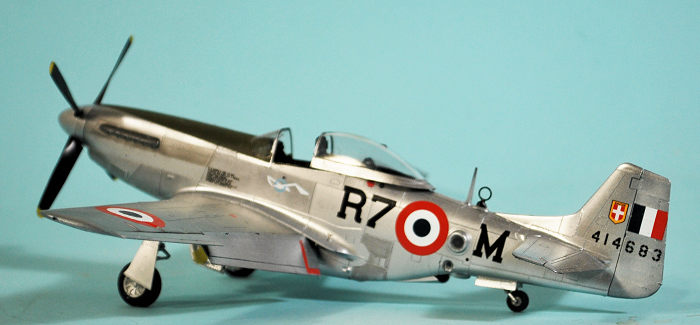 The
French F-6s flew their first operational sortie on February 19, 1945, and were
fired on by flack from both German and French forces. An angry pilot wrote: "The
flak is heavier and more accurate everyday, and by chance, our planes are fired
upon by French anti-aircraft artillery. Even French fighters attack us and Lt.
Chautemps returned to base with two 20 mm hits in the wing, one aileron missing,
and two .30 cal hits in the engine". He had been attacked by a Spitfire of
Groupe de Chasse GC II/7 Nice.
The
French F-6s flew their first operational sortie on February 19, 1945, and were
fired on by flack from both German and French forces. An angry pilot wrote: "The
flak is heavier and more accurate everyday, and by chance, our planes are fired
upon by French anti-aircraft artillery. Even French fighters attack us and Lt.
Chautemps returned to base with two 20 mm hits in the wing, one aileron missing,
and two .30 cal hits in the engine". He had been attacked by a Spitfire of
Groupe de Chasse GC II/7 Nice.
On March 20, II/33 registered its first Mustang loss. During a mission over the Black Forest, Lieutenant Labadie's aircraft, hit by flak, ran into the ground and exploded. Unknown to his wingman, Lt. Rey, who reported him killed in the crash, he had managed to bail out in time only to be captured by the Germans.
On March 24, the group moved from Luxeuil-les-Bains to Colmar, where it was caught by German heavy artillery fire on the night of March 29, which killed Lieutenant Boillot, a member of the famous pre-war Etampes aerobatics flight. The group was sent back to Luxeuil and missions were organized to locate and destroy the German artillery. A few days later, II/33 was back in Colmar for the crossing of the Rhine. On March 29, they photographed 22 miles of the Rhine's right bank, from Karslruhe to Speer, for the 2nd French Army Corps, which crossed on March 31.
Immediately after the crossing, the Mustangs engaged in "army corps reconnaissance missions" which were very dangerous since they were flown at very low altitude in bad weather. On April 17, Lt. Sainflou and Lt. Delgue were jumped by a dozen Bf 109s. Sainflou narrowly escaped by diving low, but Delègue was never seen again. Lt. Labadie returned to the group on April 23, having escaped from a prisoner convoy.
The Mustangs then gave support to the 1st French Army in combat with remnants of three German divisions in the Black Forest. They were able to locate with precision the enemy units, thus allowing their encirclement and defeat. This action owed them the congratulations of General Béthouard, commander of the 1st French Army: "Warmest thanks for the most effective help your crews gave to the ground troops, particularly on April 25, when reconnaissance and attack aircraft played a capital role in stopping and destroying powerful enemy formations trying to escape from the Black Forest towards the east. Their intervention, which was almost instant and lasted all day, cost the enemy very heavy losses and forbid it any movement, allowing its encirclement and capture. Very large numbers of troops were captured: several thousand men, representing the remnants of three divisions."
Between November 13, 1944 and April 15, 1945, GR II/33 Savoie logged 1,052 flight hours during 730 sorties. Between April 16, 1945, and May 8, 1945, they flew 189 sorties in 324 flight hours. These included 13 photo-recon missions, taking 860 photos including 660 during the coverage of the Rhine's right bank. The 136 vertical photo-recon missions, with 4400 photos taken located 15 radar stations, 41 heavy AAA guns, 685 medium or light AAA guns, 11 heavy artillery guns and 25 medium ones, 15 mortar guns, 314 automatic weapons, 42 strongpoints, 21 bunkers, 47 road barrages, 10 anti-tank trenches, 42 depots, 5 radio stations, nearly 50 trains, and over 400 railroad and road cuts.
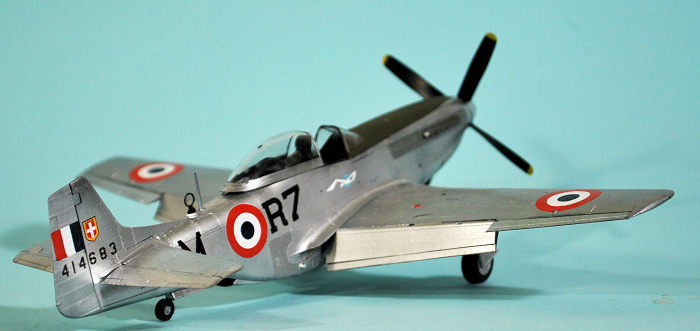 On May 9,
1945, nine Mustangs of the GR II/33 took part in the VJ-Day flypast over the
Champs-Elysées. In the following weeks, numerous flypasts were made, and the
group was visited by a team of movie-makers for an upcoming production.
On May 9,
1945, nine Mustangs of the GR II/33 took part in the VJ-Day flypast over the
Champs-Elysées. In the following weeks, numerous flypasts were made, and the
group was visited by a team of movie-makers for an upcoming production.
The unit's success resulted in members being awarded 17 crosses of the Legion of Honour, as well as 14 American awards including four Distinguished Flying Crosses.
On July 2, 1945, General de Gaulle awarded II/33 the Croix de Guerre avec palme, France’s highest unit award. II/33 left Colmar for Fribourg on September 12, 1945, replaced by pilots of GR I/33 Belfort. By December 1947, II/33 still had 20 Mustangs on strength: 13 F-6Cs, six F-6Ds and a piggy-back F-6K. A month later, that number was down to 16, four Mustangs having been sent for storage in Rennes.
By June 1947, the Mustang’s canopies were rapidly deteriorating, and several were declared non-operational. In 1950, GR 2/33 Savoie left for Cognac. An average of 16 aircraft available had been maintained, although accidents were still happening regularly. Flight hours were kept between 100 and 300 hours a month depending on conditions. GR 2/33 kept flying its Mustangs, 200 to 300 hours per month during 1951 and 1952. Attrition due to accidents was still too common, but the group still fielded 16 aircraft. In November 1951, 2/33 took part in the FTX51 combined maneuvers at Wiesbaden, completing 78 sorties.
In November 1952, six F-84G Thunderjets were delivered to 2/33. Eight Mustangs remained by September 1953, and all were gone by October. They were returned to the Americans who scrapped them, marking the end of Mustang operations in the Armée de l'Air.
| THE KIT |
This F-6D/K from Eduard marks the first time the recon Mustang has been released as a stand-alone kit in 1/48. Previously, a modeler could create the photo Mustang with aftermarket resin.
The kit substitutes the left fuselage half of the P-51D kit, with the camera apertures molded in. Decals are provided for six F-6D/K Mustangs operated in the ETO, Italy, China-Burma-India, and Philippines/Okinawa.
| CONSTRUCTION |
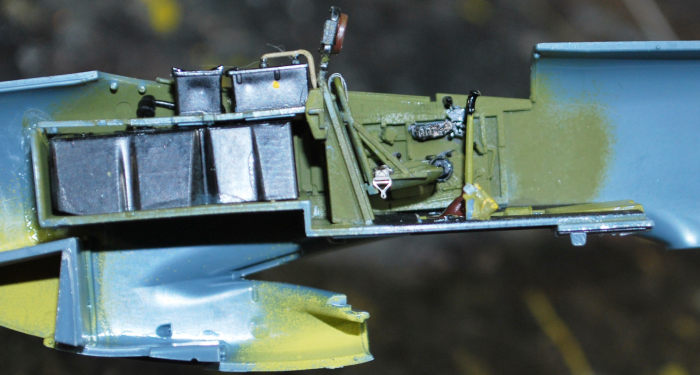 This kit
assembles similarly to the other Eduard P-51D kits. The kits have a reputation
for being “fiddly,” with the primary “fiddliness” being with the mating of the
wing and fuselage sub-assemblies. No matter how often one builds a particular
kit, there is always opportunity to learn something new. While building this
model, I discovered that if Part G-34, which the instructions would have you
glue to the top of the main gear well, is instead glued to the cockpit floor
that it is supposed to match up to, while the attachment point on the wheel well
is cut off, this solves the wing/fuselage “fiddliness.” You no longer have to
blindly try to fit that part to the cockpit without being able to see it. If you
do this, the wing will “click” into position without any hassle.
This kit
assembles similarly to the other Eduard P-51D kits. The kits have a reputation
for being “fiddly,” with the primary “fiddliness” being with the mating of the
wing and fuselage sub-assemblies. No matter how often one builds a particular
kit, there is always opportunity to learn something new. While building this
model, I discovered that if Part G-34, which the instructions would have you
glue to the top of the main gear well, is instead glued to the cockpit floor
that it is supposed to match up to, while the attachment point on the wheel well
is cut off, this solves the wing/fuselage “fiddliness.” You no longer have to
blindly try to fit that part to the cockpit without being able to see it. If you
do this, the wing will “click” into position without any hassle.
| COLORS & MARKINGS |
The French F-6s were notable for not having any colorful markings associated with them past the small unit insignia. Thus, a modeler will have to do an all-NMF finish, with nothing to distract the viewer’s eye from any mistakes or lack of ability.
I began by painting the wings, which are painted with aluminum lacquer over the putty on the real thing, with Tamiya XF-16 “Flat Aluminum,” which I thinned 50-50 with Micro Coat “Gloss.” This got rid of the graininess that can be associated with this paint, and gave a nice smooth finish that looked exactly like aluminum lacquer. Using the Tamiya paint, which can be masked when dry without problem, solved one of the main problems in painting a P-15 in NMF. When dry, I masked off the wing with low-tack drafting tape, leaving the fuel tank in the lower wing unmasked. I also painted the fabric-covered rudder with this mixture. I also painted the anti-glare area with a mixture of Tamiya Olive Drab and Khaki Drab, then masked off.
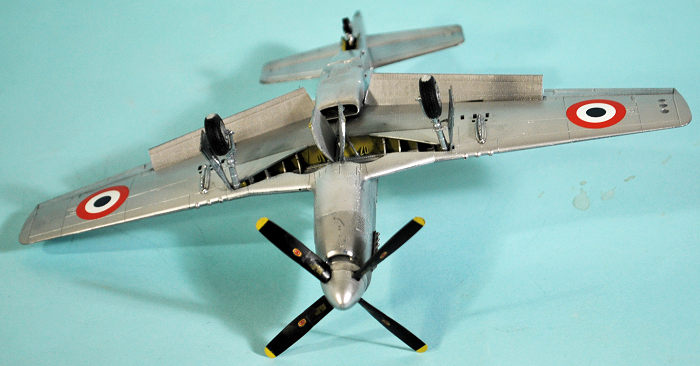 The model
was then given an overall primer of Tamiya X-18 “Semi-Gloss Black” thinned 50-50
and misted on. This was followed with a coat of Vallejo “Aluminum.” After
allowing this to set up overnight and fully dry, it was easy to mask over the
paint with the low-tack drafting tape.
The model
was then given an overall primer of Tamiya X-18 “Semi-Gloss Black” thinned 50-50
and misted on. This was followed with a coat of Vallejo “Aluminum.” After
allowing this to set up overnight and fully dry, it was easy to mask over the
paint with the low-tack drafting tape.
The gas tank on the lower wing was painted with Vallejo “Dull Aluminum,” which was also used for panels around the radiator scoop in the lower fuselage. Other panels were masked off and painted with Vallejo “Semi-Matte Aluminum.” The panels behind the exhaust stacks were masked off and painted with Vallejo “Duraluminum.”
Done right, Vallejo paints do not need any clear coat to protect them. Thus, when all the masking was removed, I had a multi-hue multi-color overall aluminum finish.
The French distributor of Tamiya kits used to do special releases, and back in 2003 they did an F-6 conversion. My friend Sebastien Privat had sent me the resin parts and the decals for II/33 Savoie F-6Ds; I used the resin parts for the RF-51D I reviewed here in 2003. When this kit arrived, I went through the decal dungeon and discovered these decals, still good aver 17 years in their storage box. The decals went on without problem under a coat of Solvaset. I particularly liked that the squadron ID codes did not have any clear surround.
I assembled and attached the landing gear and the prop, and positioned the canopy open.
| CONCLUSIONS |
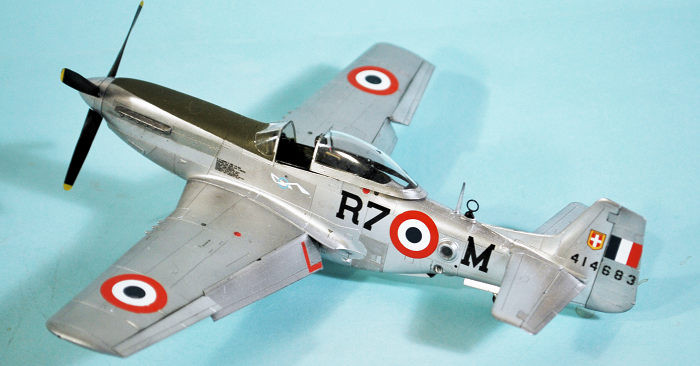 It’s an
Eduard Mustang, what else needs be said? These are the best P-51D kits in 1/48.
This release allows a modeler to do the recon variant without having to cut up
the fuselage to fit resin camera ports. As with all other Eduard kits, the close
parts design tolerances mean you have to clean off all sprue nubs and be careful
in assembly to get it right. If you do this, you are guaranteed an excellent
result. Recommended for all Mustang fans with experience doing Eduard kits.
It’s an
Eduard Mustang, what else needs be said? These are the best P-51D kits in 1/48.
This release allows a modeler to do the recon variant without having to cut up
the fuselage to fit resin camera ports. As with all other Eduard kits, the close
parts design tolerances mean you have to clean off all sprue nubs and be careful
in assembly to get it right. If you do this, you are guaranteed an excellent
result. Recommended for all Mustang fans with experience doing Eduard kits.
One notice: many modelers are going to want to do Captain Clyde East’s F-6D “Li’l Margaret” with this kit. It turns out (thank you Tom Ivie for the photos) that You Cannot Get There From Here, since East’s F-6D had a modified set of camera ports, and was not a “stock” F-6D. It turns out to be an easy conversion from the standard P-51D kit. So, if you want to do “Li’l Margaret,” wait until I get my conversion done, so you can see what you’ll need to do. You could, of course, use this kit to do the “warbird” of “Li’l Margaret,” which is a restored F-6D with the standard camera ports.
28 January 2021 Copyright ModelingMadness.com. All rights
reserved. Review kit
courtesy of Mrs. Santa Claus If you would like your product reviewed fairly and
fairly quickly, please
contact
the editor or see other details in the
Note to
Contributors.